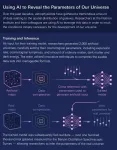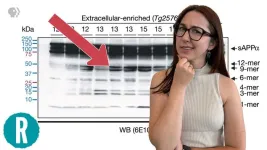(Press-News.org) How would you summarize your study for a lay audience?
Immune checkpoint inhibitors are cancer fighting drugs that help the immune system do its job of detecting and attacking tumor cells. Programmed Cell Death 1 (PD-1) is a common target for this type of drug—it is a protein that sits on the surface of T cells and helps regulate the immune system’s response to neighboring cells, both normal and cancerous. While most research efforts to date have focused on PD-1’s role in T cells, it is also active in many other kinds of cells—including cancer cells as first demonstrated by the Schatton laboratory.
We aimed to define the molecular mechanisms controlling PD-1 expression and its therapeutic targeting in melanoma cells. Our team identified a melanoma cell-intrinsic type I interferon-JAK/STAT signaling circuit regulating the amount of PD-1 in tumor cells. We further discovered that inhibition of this pathway not only reversed induction of PD-1 on melanoma cells, but also reduced the efficacy of PD-1 checkpoint therapy. Our work thus cautions against combining JAK or IFNAR antagonists with PD-1 inhibitors, given that this regimen may weaken the effectiveness of immune checkpoint monotherapy.
What knowledge gaps does your study help to fill?
This work builds off our previously published studies identifying PD-1 as a tumor cell-intrinsic growth promoting receptor in melanoma and Merkel cell carcinoma, the inhibition of which suppresses cancer progression. Here, we newly define a regulatory pathway controlling PD-1 levels on melanoma cells and how inhibition of this pathway unintentionally disrupts therapeutic efficacy of immune checkpoint blockade. We can use these findings to optimize immunotherapeutic responses for patients with melanoma, and potentially even other cancer types.
How did you conduct your study?
To understand the mechanisms that govern PD-1 checkpoint expression in melanoma cells, we focused on established cytokine networks known to regulate PD-1 in immune cells. We hypothesized that these mediators would have a similar role in modulating melanoma cell-PD-1 levels. Through our work, we discovered that a type I interferon cytokine pathway intrinsic to melanoma cells critically controls tumor cell-PD-1 expression. We also found that disruption of type I interferon signaling reduces melanoma-PD-1 expression and resultant efficacy of immune checkpoint therapy.
What are the implications?
Type I interferon antagonists, including JAK inhibitors and IFNAR1 antibodies, currently prescribed in the clinic for multiple autoimmune conditions such as psoriasis, atopic dermatitis, vitiligo and lupus may potentially suppress efficacy of PD-1 immune checkpoint therapy. Our work thus raises concern over using PD-1 checkpoint antibodies (e.g. nivolumab or pembrolizumab) with JAK inhibitors (e.g. ruxolitinib, utabacitinib, deucravacitinib) or IFNAR1 antibodies (e.g. anifrolumab).
What are the next steps?
Next steps include dissecting roles of type I interferon signaling and inhibition not only on melanoma cell-PD-1 expression, targeting, and checkpoint efficacy, but also in additional cancer types as well as in diverse immune and non-immune cell lineages within the tumor microenvironment. Identifying additional regulatory networks controlling tumor cell-PD-1 expression and their effects on immunotherapeutic outcomes are also major thrusts of our ongoing research. Our overall goal is to leverage these findings to improve immune checkpoint therapeutic responses in cancer patients.
Authorship: In addition to Drs. Schatton and Barthel, other BWH authors include Julia Holzgruber, Christina Martins, Zsofi Kulcsar, Alexandra Duplaine, Erik Rasbach, Laure Migayron, Praveen Singh, Edith Statham, and Matthew R. Ramsey. Additional non-BWH authors include Jennifer Landsberg, Katia Boniface, Julien Seneschal, Wolfram Hoetzenecker, Emma Berdan and Shannah Ho Sui.
Funding: This work was support by a Research Grant from the Dermatology Foundation, Milstein Research Scholar Award from the American Skin Association, Fund to Sustain Research Excellence from the Brigham Research Institute at Brigham and Women’s Hospital and NIH/NCI grants (R01CA190838, R01CA247957 and R01CA258637). Partial support was provided by a Developmental Project Grant from the Harvard Stem Cell Institute, Klaus-Wolff Fellowships from the Austrian Society of Dermatology and Venereology, Marietta Blau-Grant from Austria’s Agency for Education and Internationalisation, Research Fellowship from the European Academy of Dermatology and Venereology, and a Walter Benjamin Scholarship from the German Research Foundation.
Disclosures: Drs. Schatton and Barthel declare no competing interests.
Paper cited: Holzgruber J et al. “Type I interferon signaling induces melanoma cell-intrinsic PD-1 and its inhibition antagonizes immune checkpoint blockade.” Nature Communications DOI: 10.1038/s41467-024-51496-2 / NCOMMS-24-01765-T
END
Research spotlight: Key regulators of pd-1 in melanoma cells and the immune system’s response
2024-08-26
ELSE PRESS RELEASES FROM THIS DATE:
Lighting the way for quantum innovation
2024-08-26
ALBUQUERQUE, N.M. — Sandia National Laboratories and Arizona State University, two research powerhouses, are collaborating to push the boundaries of quantum technology and transform large-scale optical systems into compact integrated microsystems.
Nils Otterstrom, a Sandia physicist specializing in integrated photonics, is at the forefront of scaling down optical systems to the size of a chip. This innovation offers performance advantages and scalability for an array of applications from advanced computing to secure communications.
“Integrated ...
Spin squeezing for all
2024-08-26
Nothing in science can be achieved or understood without measurement. Today, thanks to advances in quantum sensing, scientists can measure things that were once impossible to even imagine: vibrations of atoms, properties of individual photons, fluctuations associated with gravitational waves.
A quantum mechanical trick called “spin squeezing” is widely recognized to hold promise for supercharging the capabilities of the world’s most precise quantum sensors, but it’s been notoriously difficult to achieve. In new research, Harvard physicists describe how they’ve put spin squeezing ...
NSF funds research on the effects of evolution and food webs in climate change response
2024-08-26
Colorado State University is leading a new interdisciplinary research project into the ways predators and prey in sensitive ecosystems may react to climate change based on their physiology, genetics and relationships to each other.
Led by Professor Chris Funk in the Department of Biology, the project is funded by the National Science Foundation’s Organismal Response to Climate Change program and will focus on interactions between cutthroat trout and tailed frogs in Pacific Northwest streams. This approach is one of the first times researchers have tried to test both the effects of evolution and ...
Children's Brain Tumor Network hosts 2024 CBTN Summit to transform scientific research and patient care
2024-08-26
What:
The 2024 CBTN Summit hosted by the Children's Brain Tumor Network (CBTN) assembles the brightest minds in Pediatric Brian Tumor research for this annual conference. The event is free but attendees must register in advance.
Register at network.cbtn.org/cbtn-summit
Where:
In person at AWS Headquarters
Amazon WAS16 Aurora, 1770 Crystal Dr, Arlington, VA 22202
Virtual attendance available worldwide.
When:
October 9-11, 2024
Why:
This event is an opportunity ...
Long-term prognosis of patients with myocarditis attributed to COVID-19 mRNA vaccination, SARS-CoV-2 infection, or conventional etiologies
2024-08-26
About The Study: Patients with post–COVID-19 mRNA vaccination myocarditis, contrary to those with post–COVID-19 myocarditis, show a lower frequency of cardiovascular complications than those with conventional myocarditis at 18 months. However, affected patients, mainly healthy young men, may require medical management up to several months after hospital discharge.
Corresponding Authors: To contact the corresponding authors, email Laura Semenzato, MSc (laura.semenzato@assurance-maladie.fr) and Mahmoud Zureik, MD, PhD (Mahmoud.ZUREIK@ansm.sante.fr).
To access the embargoed study: Visit our For The ...
LZ experiment sets new record in search for dark matter
2024-08-26
Figuring out the nature of dark matter, the invisible substance that makes up most of the mass in our universe, is one of the greatest puzzles in physics. New results from the world’s most sensitive dark matter detector, LUX-ZEPLIN (LZ), have narrowed down possibilities for one of the leading dark matter candidates: weakly interacting massive particles, or WIMPs.
LZ, led by the Department of Energy’s Lawrence Berkeley National Laboratory (Berkeley Lab), hunts for dark matter from a cavern nearly one mile underground at the Sanford Underground Research Facility in South Dakota. The experiment’s new results explore weaker dark matter interactions ...
Astrophysicists use AI to precisely calculate universe’s ‘settings’
2024-08-26
The standard model of the universe relies on just six numbers. Using a new approach powered by artificial intelligence, researchers at the Flatiron Institute and their colleagues extracted information hidden in the distribution of galaxies to estimate the values of five of these so-called cosmological parameters with incredible precision.
The results were a significant improvement over the values produced by previous methods. Compared to conventional techniques using the same galaxy data, the approach yielded less than half ...
SETI Institute starts first low frequency search for alien technology in distant galaxies
2024-08-26
August 26, 2024, Mountain View, CA -- The SETI Institute, the Berkeley SETI Research Center and the International Centre for Radio Astronomy Research announced a groundbreaking study using the Murchison Widefield Array (MWA) in Western Australia. Led by Dr. Chenoa Tremblay of the SETI Institute and Prof. Steven Tingay of Curtin University, this research is the first to search for signs of alien technology in galaxies beyond our own, focusing on low radio frequencies (100 MHz). This innovative study used the MWA’s large field of view (FOV), allowing the team to cover about 2,800 galaxies in one observation, of which 1300 we know the distance to. Usually, the search for extraterrestrial ...
Bicycle rolling-stop laws don’t lead to unsafe behavior by riders or motorists, research shows
2024-08-26
CORVALLIS, Ore. – Laws that let bicyclists treat stop signs as yield signs lead neither riders nor motorists to act unsafely, according to a groundbreaking Oregon State University study.
The project by OSU College of Engineering researchers featured a novel experimental technique – linking separate bicycle and motor vehicle simulators – and the findings are important as more and more states consider bicycle rolling-stop legislation, said David Hurwitz, the study’s leader.
“It required fully connecting two independent simulators, running subjects in pairs simultaneously and having each subject interacting with an avatar of the other in a shared virtual ...
How a retracted paper affected the course of Alzheimer’s research (video)
2024-08-26
WASHINGTON, Aug. 26, 2024 — In June 2024, a landmark Alzheimer's research paper was retracted due to fraud allegations. Did we waste billions of dollars and thousands of hours of scientists’ time? Maybe not. There are now two potentially helpful drugs on the market targeting the subject of the paper: amyloid beta. This video breaks down the amyloid-beta hypothesis, the fraud itself and where we go from here.
Reactions is a video series produced by the American Chemical Society and PBS Digital Studios. Subscribe to Reactions and follow us on X, formerly Twitter @ACSReactions.
The American Chemical ...








